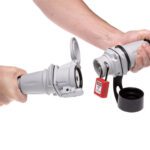Power Contacts/Connectors – Part III: Current Rating 1
Power Contacts/Connectors
Part III: Current Rating 1
A number of issues need resolution in order to perform a current rating test program. Both practical and philosophical issues should be taken into consideration as you embark on this process. We first discuss the practical issues.
The relevant document for this discussion is EIA 364 D: TP-70B, temperature rise vs. current for electrical connectors and sockets (June 1997). As noted earlier and referenced in the title of TP-70B, current rating is based on the T-rise of a connector under current flow. T-rise is defined as the difference between the ambient temperature of the test environment and the temperature of the hottest point—the hot spot—on the energized contact. The most common T-rise criterion is a 30-degree Centigrade difference as specified by Underwriters Laboratories, a standards organization primarily dedicated to safety issues.
TP-70B discusses temperature measurement issues in some detail. Measurement of the ambient temperature is straightforward; the measurement of the contact hot-spot temperature is more involved. Two cases are discussed. In the first case, the contact hot spot is accessible for a thermocouple or infra-red temperature measurement. The second occurs when the hot spot is not accessible. Details for such a measurement are still “to be determined” in TP-70B, but some comments about this measurement are just ahead.
Accessible contact temperature measurement is defined in some detail in TP-70B. The key points are thermocouple size and placement, and IR measurement capabilities. Contacts within a housing are not necessarily inaccessible. TP-70B describes procedures to provide thermocouple access to such contacts. IR access is not discussed.
Inaccessible contacts are more problematic. The main challenge is developing a correlation between the temperature at the hot spot with some point on the contact which is accessible. The correlation can be derived from either thermocouple or IR measurements using contacts that are not mounted in the connector housing. The expected rated current can be applied to such contacts, mounted in air, and the steady-state temperatures at the hot spot and accessible point can be measured. The difference in those temperatures is then assumed to be the same when the contacts are inserted in the housing. This, of course, is not necessarily the case, but because all T-rise measurements are comparative, ensuring that all qualification testing is done under identical measurement protocols will lead to consistent evaluation of relative product performance. The resolution or agreement on temperature measurement protocols are generally straightforward.
A second testing issue involves the definition of steady-state T-rise. This issue is addressed in detail in TP-70B. Section 4.1.3.1 is quoted in full:
“Maintain current until thermal stability is achieved on all specimens. Thermal stability shall be achieved when the temperature rise of a minimum of three consecutive readings taken at five-minute intervals maximum does not differ by more than ± 1°C (1.8°F) for each thermocouple being used for monitoring. Thermal stability applies to all current applications for all test methods described herein.”
Procedures for achieving stability by gradually increasing applications of current are also included.
Two philosophical issues are also important. The first is how to mount the contact to perform the T-rise measurement, in free air or in the housing. The second is the state of the contact in terms of any conditioning steps. The extremes of this decision are a contact as manufactured, that is, with no conditioning, to be referenced as Out Of the Box (OOB), and a contact conditioned to an End Of Life (EOL), state.
Consider first, free air vs. mounted in the housing. The T-rise of a contact will be determined by the balance of Joule (I2R) heating, which increases the temperature of the contact, and thermal dissipation, primarily through conduction and convection, which decreases the temperature of the contact. Clearly, free air measurements will provide a greater degree of heat dissipation compared to an in-housing measurement. However, application conditions use contacts in housings, so in-housing measurements are typically preferred.
Now, let’s look at decisions relevant to contact conditioning. Testing OOB contacts verifies that the design objectives of the contact have been met. But such measurements provide no indication of the performance stability of the contacts in the field. Thus, some variant of an EOL conditioning is more appropriate prior to exposure to a current rating test program. Two examples illustrate the difference between OOB and EOL.
First, a product is generally designed to have a specific application life in the field; this is the “L” in EOL. Say that L is 10 years, a high quality white goods product, for example. It is well known that contact normal force is a critical parameter in the performance and, in particular, to the stability of a connector system.
It is also well known that contact normal force decreases with time through stress relaxation, a time and temperature dependent process. For the white goods application under consideration, the application temperature will be approximately room temperature. A 10-year lifetime at room temperature can be simulated by a shorter time at an elevated temperature, thus a 10-year life may be simulated by a few months of testing at a higher temperature. An OOB test will not provide any information about this potential degradation mechanism.
Second, a connector is typically rated for some number of mating cycles. This parameter is intended to validate the integrity of the contact finish against wear processes during mating. The number of mating cycles corresponding to EOL is application dependent. In many applications, a few mating cycles will be sufficient. In others, higher numbers may be appropriate. Consider, for example, the USB printer socket on a laptop computer. Some users may use their laptop primarily at home, so their printer socket will be exposed to only a few or a few tens of mating cycles. On the other hand, a field salesperson will be using the laptop on the road and at home, and may accumulate several hundred mating cycles over a few years. What is EOL for a printer USB socket? Is it appropriate to test for a typical—whatever that means—user, say, several tens of cycles? Or, is it more appropriate to test to the design EOL, say 500 mating cycles. Mating cycles can be performed quickly and at low cost, so the issue here is not the test conditioning, the issue is performance.
Different choices of EOL can be rationalized. The important point, particularly from a user perspective, is to make sure that the test programs are consistent. A stress relaxation or heat age test of 10 days at 75 degrees Centigrade is much less demanding than a 30-day test at 125 degrees Centigrade. Just to put in a new consideration, more is not necessarily better. Depending on the contact system dependence on the housing, a 30-day, 125-degree-Centigrade heat age test may not be appropriate due to contributions attributable to housing degradation. That, however, is a different article.
For this article, the final point to consider is what exposures that simulate EOL, however defined, are appropriate. While the list of exposures can be very long, I suggest that there are four indispensable exposures: durability, heat age, corrosion, and mechanical stability. We’ll talk about them next time.
- Nanocrystalline Silver Alloy Contact Finishes in Electronic Applications - April 6, 2015
- Nanocrystalline Silver Contact Platings - March 16, 2015
- Dr. Bob on Gold Flash Contact Finishes (and Max Peel) - September 22, 2014







